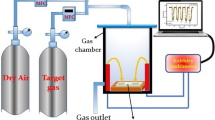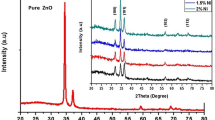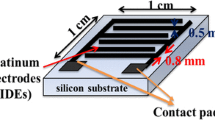Abstract
The study investigates the impact of nickel do** on the structural, optical, morphological, and gas sensing properties of zinc oxide (ZnO) thin films. Films were synthesized using a spray pyrolysis technique on a glass substrate. Structural and morphological analyses were conducted through X-ray diffraction (XRD) and field emission scanning electron microscopy (FESEM). XRD revealed a hexagonal wurtzite structure, primarily aligned along (101) planes. However, nickel do** prompted a preferred orientation towards (002) plane. Lattice parameters decreased systematically, due to the ionic radii mismatch between dopant and host. FESEM showed a nanoflake morphology. Compositional analysis with energy dispersive X-ray spectroscopy (EDX) confirmed successful do**. Optical analysis using UV–Vis spectroscopy indicated high transmission in undoped ZnO films. However reduced band gap values have been reduced with nickel incorporation. Gas sensing response observed to be significantly improved with Nickel do** in ZnO.









Similar content being viewed by others
Data availability
The data that support the findings of this study are not openly available due to reasons of sensitivity and are available from the corresponding author upon reasonable.
References
N. Nasiri, C. Clarke, Nanostructured gas sensors for medical and health applications: low to high dimensional materials. Biosensors 9, 43 (2019). https://doi.org/10.3390/bios9010043
C. Li, P.G. Choi, Y. Masuda, Large-lateral-area SnO2 nanosheets with a loose structure for high-performance acetone sensor at the PPT level. J. Hazard. Mater. 455, 131592 (2023). https://doi.org/10.1016/j.jhazmat.2023.131592
J. Bhaliya, V. Shah, G. Patel, Functionalized nanofibers for gas and volatile organic compound sensing. Functionalized Nanofibers. (2023). https://doi.org/10.1016/b978-0-323-99461-3.00030-3
S. Gupta Chatterjee, S. Chatterjee, A.K. Ray, A.K., Chakraborty, Graphene–metal oxide nanohybrids for toxic gas sensor: a review. Sens. Actuators B Chem. 221, 1170–1181 (2015). https://doi.org/10.1016/j.snb.2015.07.070
S. Agarwal, P. Rai, E.N. Gatell, E. Llobet, F. Güell, M. Kumar et al., Gas sensing properties of ZnO nanostructures (flowers/rods) synthesized by hydrothermal method. Sens. Actuators B Chem. 292, 24–31 (2019). https://doi.org/10.1016/j.snb.2019.04.083
D. Nagmani, A. Pravarthana, T.C. Tyagi, W. Jagadale, D.K. Prellier, Aswal, highly sensitive and selective H2S gas sensor based on Tio2 thin films. Appl. Surf. Sci. 549, 149281 (2021). https://doi.org/10.1016/j.apsusc.2021.149281
H. Abdollahi, M. Samkan, M.M. Hashemi, Fabrication of RGO nano-sheets wrapped on Ni doped ZnO nanowire P-N heterostructures for hydrogen gas sensing. New J. Chem. 43, 19253–19264 (2019). https://doi.org/10.1039/c9nj05152j
S. Mahajan, S. Jagtap, Metal-oxide semiconductors for carbon monoxide (CO) gas sensing: a review. Appl. Mater. Today 18, 100483 (2020). https://doi.org/10.1016/j.apmt.2019.100483
J.-H. Lin, T. Yang, X. Zhang, B.-C. Shiu, C.-W. Lou, T.-T. Li, MN-doped ZnO/SnO2-based yarn sensor for ammonia detection. Ceram. Int. (2023). https://doi.org/10.1016/j.ceramint.2023.07.222
A.M. Abdelraheem, M.A. Abdel-Rahim, D. Hamad, A.M. Abd-Elnaiem, Physical characterizations and methane gas–sensing of Al Zn1-o nanoparticles. Appl. Surf. Sci. 619, 156729 (2023). https://doi.org/10.1016/j.apsusc.2023.156729
S. Liu, W. Yang, L. Liu, H. Chen, Y. Liu, Enhanced H2S gas-sensing performance of Ni-doped ZnO nanowire arrays. ACS Omega 8, 7595–7601 (2023). https://doi.org/10.1021/acsomega.2c07092
P.K. Singh, N. Singh, S.K. Singh, M. Singh, P. Tandon, Co-doped ZnO nanostructures for liquefied petroleum gas sensing at room temperature. J. Mater. Sci. Mater. Electron. (2023). https://doi.org/10.1007/s10854-023-10344-7
W.A. dos Santos Silva, B.S. de Lima, M.I. Bernardi, V.R. Mastelaro, Enhancement of the ozone-sensing properties of ZnO through chemical-etched surface texturing. J. Nanopart. Res.Nanopart. Res. (2022). https://doi.org/10.1007/s11051-022-05479-3
S. Jain et al., Development of ni doped ZnO/polyaniline nanocomposites as high response room temperature NO2 sensor. Mater. Sci. Eng. B 247, 114381 (2019). https://doi.org/10.1016/j.mseb.2019.114381
H. Liu, Q. Zhou, H. Wei, W. Hu, L. Xu, C. Tang et al., A comparative study of zinc oxide based chemical gas sensors for sulfur dioxide detection. Sens. Lett. 15, 384–388 (2017). https://doi.org/10.1166/sl.2017.3789
M. Que, C. Lin, J. Sun, L. Chen, X. Sun, Y. Sun, Progress in ZnO nanosensors. Sensors. 21, 5502 (2021). https://doi.org/10.3390/s21165502
S.V. Trukhanov, A.V. Trukhanov, V.G. Kostishyn, N.S. Zabeivorota, L.V. Panina, A.V. Trukhanov et al., High-frequency absorption properties of gallium weakly doped barium hexaferrites. Philos. Mag. 99, 585–605 (2018). https://doi.org/10.1080/14786435.2018.1547431
D.A. Vinnik, AYu. Starikov, V.E. Zhivulin, K.A. Astapovich, V.A. Turchenko, T.I. Zubar et al., Changes in the structure, magnetization, and resistivity of BaFe12– xTixO. ACS Appl. Electron. Mater. 3, 1583–1593 (2021). https://doi.org/10.1021/acsaelm.0c01081
F.G. Agayev, S.V. Trukhanov, A.V. Trukhanov, S.H. Jabarov, G.S. Ayyubova, M.N. Mirzayev et al., Study of structural features and thermal properties of barium hexaferrite upon indium do**. J. Therm. Anal. Calorim.Calorim. 147, 14107–14114 (2022). https://doi.org/10.1007/s10973-022-11742-5
R.E. El-Shater, A.S. Atlam, M.K. Elnimr, S.T. Assar, D.I. Tishkevich, T.I. Zubar et al., AC measurements, impedance spectroscopy analysis, and magnetic properties of Ni0.5Zn0.5Fe2O4/BaTiO3 Multiferroic Composites. Mater. Sci. Eng. B 286, 116025 (2022). https://doi.org/10.1016/j.mseb.2022.116025
A.L. Kozlovskiy, M.V. Zdorovets, Effect of do** of Ce4+/3+ on optical, strength and shielding properties of (0.5–x)TeO2–0.25MoO-0.25Bi2O3-xCeO2 glasses. Mater. Chem. Phys. 263, 124444 (2021). https://doi.org/10.1016/j.matchemphys.2021.124444
M.A. Darwish, T.I. Zubar, O.D. Kanafyev, D. Zhou, E.L. Trukhanova, S.V. Trukhanov et al., Combined effect of microstructure, surface energy, and adhesion force on the friction of PVA/Ferrite Spinel nanocomposites. Nanomaterials 12, 1998 (2022). https://doi.org/10.3390/nano12121998
A.M. Henaish, M.A. Darwish, O.M. Hemeda, I.A. Weinstein, T.S. Soliman, A.V. Trukhanov et al., Structure and optoelectronic properties of ferroelectric PVA-PZT Nanocomposites. Opt. Mater. 138, 113402 (2023). https://doi.org/10.1016/j.optmat.2022.113402
A. Murtaza, W. Zuo, X. Song, A. Ghani, A. Saeed, M. Yaseen et al., Robust ferromagnetism in rare-earth and transition metal co-doped ZnO nanoparticles for Spintronics applications. Mater. Lett. 310, 131479 (2022). https://doi.org/10.1016/j.matlet.2021.131479
R. Röder, S. Geburt, M. Zapf, D. Franke, M. Lorke, T. Frauenheim et al., Transition metal and rare earth element doped zinc oxide nanowires for optoelectronics. Phys. Status Solidi (b). 256, 1800604 (2019). https://doi.org/10.1002/pssb.201800604
P. Singh, R. Kumar, R.K. Singh, Progress on transition metal-doped ZnO nanoparticles and its application. Ind. Eng. Chem. Res. 58, 17130–17163 (2019). https://doi.org/10.1021/acs.iecr.9b01561
H.Y. Salah, M. Bakry, M. Kubas, W. Ismail, M.I. El-Henawey, A.H. Oraby et al., Improvement of the structural, morphological, optical, and photoelectrochemical properties of al-doped ZnO nanorods for use in biosensors and solar cells. Eur. Phys. J. Plus. (2022). https://doi.org/10.1140/epjp/s13360-022-03532-7
K. Qi, X. **ng, A. Zada, M. Li, Q. Wang, S. Liu et al., Transition metal doped ZnO nanoparticles with enhanced photocatalytic and antibacterial performances: experimental and DFT Studies. Ceram. Int. 46, 1494–1502 (2020). https://doi.org/10.1016/j.ceramint.2019.09.116
Y. Luo, A. Ly, D. Lahem, C. Zhang, M. Debliquy, A novel low-concentration isopropanol gas sensor based on Fe-doped ZnO nanoneedles and its gas sensing mechanism. J. Mater. Sci. 56, 3230–3245 (2020). https://doi.org/10.1007/s10853-020-05453-1
S. Zhu, L. Xu, S. Yang, X. Zhou, X. Chen, B. Dong et al., Cobalt-doped ZnO nanoparticles derived from zeolite imidazole frameworks: synthesis, characterization, and application for the detection of an exhaled diabetes biomarker. J. Colloid Interface Sci. 569, 358–365 (2020). https://doi.org/10.1016/j.jcis.2020.02.081
Y.-L. Chu, L.-W. Ji, Y.-J. Hsiao, H.-Y. Lu, S.-J. Young, I.-T. Tang et al., Fabrication and characterization of ni-doped ZnO Nanorod arrays for UV photodetector application. J. Electrochem. Soc.Electrochem. Soc. 167, 067506 (2020). https://doi.org/10.1149/1945-7111/ab7d43
O. Alev, N. Sarıca, O. Özdemir, L.Ç. Arslan, S. Büyükköse, Z.Z. Öztürk, Cu-doped ZnO nanorods based QCM sensor for hazardous gases. J. Alloy. Compd. 826, 154177 (2020). https://doi.org/10.1016/j.jallcom.2020.154177
V.L. Patil, D.S. Dalavi, S.B. Dhavale, S.A. Vanalakar, N.L. Tarwal, A.S. Kalekar et al., Indium doped ZnO nanorods for chemiresistive No2 gas sensors. New J. Chem. 46, 7588–7597 (2022). https://doi.org/10.1039/d2nj00114d
Z. El khalidi, B. Hartiti, M. Siadat, E. Comini, H.M. Arachchige, S. Fadili et al., Acetone sensor based on ni doped ZnO nanostructues: growth and sensing capability. J. Mater. Sci. Mater. Electron. 30, 7681–7690 (2019). https://doi.org/10.1007/s10854-019-01083-9
M. Xu, Q. Li, Y. Ma, H. Fan, Ni-doped ZnO nanorods gas sensor: enhanced gas-sensing properties, AC and DC electrical behaviors. Sens. Actuators, B Chem. 199, 403–409 (2014). https://doi.org/10.1016/j.snb.2014.03.108
A. Hastir, N. Kohli, R.C. Singh, Comparative study on gas sensing properties of Rare Earth (TB, Dy and Er) doped ZnO sensor. J. Phys. Chem. Solids 105, 23–34 (2017). https://doi.org/10.1016/j.jpcs.2017.02.004
E. Sener, O. Bayram, U.C. Hasar, O. Simsek, Structural and optical properties of RF sputtered ZnO thin films: annealing effect. Phys. B 605, 412421 (2021). https://doi.org/10.1016/j.physb.2020.412421
K.K. Kadyrzhanov, D.I. Shlimas, A.L. Kozlovskiy, M.V. Zdorovets, Research of the shielding effect and radiation resistance of composite CuBi2O4 films as well as their practical applications. J. Mater. Sci. Mater. Electron. 31, 11729–11740 (2020). https://doi.org/10.1007/s10854-020-03724-w
A.L. Kozlovskiy, M.V. Zdorovets, Synthesis, structural, strength and corrosion properties of thin films of the type CuX (x = Bi, Mg, Ni). J. Mater. Sci. Mater. Electron. 30, 11819–11832 (2019). https://doi.org/10.1007/s10854-019-01556-x
A. Kotelnikova, T. Zubar, T. Vershinina, M. Panasyuk, O. Kanafyev, V. Fedkin et al., The influence of saccharin adsorption on nife alloy film growth mechanisms during electrodeposition. RSC Adv. 12, 35722–35729 (2022). https://doi.org/10.1039/d2ra07118e
R.I. Shakirzyanov, A.L. Kozlovskiy, M.V. Zdorovets, A.L. Zheludkevich, D.I. Shlimas, N.V. Abmiotka et al., Impact of thermobaric conditions on phase content, magnetic and electrical properties of the COFe2O4 ceramics. J. Alloy. Compd. 954, 170083 (2023). https://doi.org/10.1016/j.jallcom.2023.170083
K. Radhi Devi, G. Selvan, M. Karunakaran, I.L. Poul Raj, V. Ganesh, S. AlFaify, Enhanced room temperature ammonia gas sensing properties of strontium doped ZnO thin films by cost-effective SILAR method. Mater. Sci. Semicond. Process.Semicond. Process. 119, 105117 (2020). https://doi.org/10.1016/j.mssp.2020.105117
V.K. Jayaraman, R.R. Biswal, A.G. Hernandez, A. Maldonado, H. Gomez-Pozos, Synthesis and characterization of chemically sprayed ZnO:Fe: Ni thin films: effect of codo** concentration and response as Gas Sensor. J. Mater. Sci. Mater. Electron. 31, 7423–7433 (2020). https://doi.org/10.1007/s10854-020-02938-2
D. Mahesh, M.C.S. Kumar, Synergetic effects of aluminium and indium dopants in the physical properties of ZnO thin films via spray pyrolysis. Superlattices Microstruct.Microstruct. 142, 106511 (2020). https://doi.org/10.1016/j.spmi.2020.106511
A. Singh, S. Sikarwar, A. Verma, B. Chandra Yadav, The recent development of metal oxide heterostructures based gas sensor, their future opportunities and challenges: a review. Sens. Actuators A Phys. 332, 113127 (2021). https://doi.org/10.1016/j.sna.2021.113127
T. Srinivasulu, K. Saritha, K.T.R. Reddy, Synthesis and characterization of Fe-doped ZnO thin films deposited by chemical spray pyrolysis. Modern Electronic Mater. 3, 76–85 (2017). https://doi.org/10.1016/j.moem.2017.07.001
V.S. Bhati, S. Ranwa, M. Fanetti, M. Valant, M. Kumar, Efficient hydrogen sensor based on ni-doped ZnO nanostructures by RF sputtering. Sens. Actuators B Chem. 255, 588–597 (2018). https://doi.org/10.1016/j.snb.2017.08.106
V.S. Kamble, Y.H. Navale, V.B. Patil, N.K. Desai, S.T. Salunkhe, Enhanced no2 gas sensing performance of Ni-doped ZnO nanostructures. J. Mater. Sci. Mater. Electron. 32, 2219–2233 (2021). https://doi.org/10.1007/s10854-020-04987-z
P. Norouzzadeh, Kh. Mabhouti, M.M. Golzan, R. Naderali, Consequence of Mn and Ni do** on structural, optical and magnetic characteristics of ZnO nanopowders: the williamson–hall method, the Kramers-Kronig approach and magnetic interactions. Appl. Phys. A (2020). https://doi.org/10.1007/s00339-020-3335-9
H.S. Rasheed, H.I. Abdulgafour, F.M. Hassan, A.A. Najim, Synthesis, characterization, and gas-sensing performance of macroporous Zn-doped NiO thin films for ammonia gas detection. J. Mater. Sci. Mater. Electron. 33, 18187–18198 (2022). https://doi.org/10.1007/s10854-022-08675-y
M. Ashokkumar, S. Muthukumaran, Effect of Ni do** on electrical, photoluminescence and magnetic behavior of Cu doped ZnO nanoparticles. J. Lumin. 162, 97–103 (2015). https://doi.org/10.1016/j.jlumin.2015.02.019
A. Kozlovskiy, K. Egizbek, M.V. Zdorovets, M. Ibragimova, A. Shumskaya, A.A. Rogachev et al., Evaluation of the efficiency of detection and capture of manganese in aqueous solutions of feceox nanocomposites doped with Nb2O5. Sensors. 20, 4851 (2020). https://doi.org/10.3390/s20174851
M. Sathya, K. Pushpanathan, Synthesis and optical properties of Pb doped ZnO nanoparticles. Appl. Surf. Sci. 449, 346–357 (2018). https://doi.org/10.1016/j.apsusc.2017.11.127
S.V. Trukhanov, V.A. Khomchenko, L.S. Lobanovski, M.V. Bushinsky, D.V. Karpinsky, V.V. Fedotova et al., Crystal structure and magnetic properties of ba-ordered Manganites Ln0.70Ba0.30MnO3−δ (Ln = Pr, Nd). J. Exp. Theor. Phys. 103, 398–410 (2006). https://doi.org/10.1134/s1063776106090093
S. Chattopadhyay, K.P. Misra, A. Agarwala, A. Shahee, S. Jain, N. Halder et al., Dislocations and particle size governed band gap and ferromagnetic ordering in Ni doped ZnO nanoparticles synthesized via co-precipitation. Ceram. Int. 45, 23341–23354 (2019). https://doi.org/10.1016/j.ceramint.2019.08.034
Z. Lu, L. Long, Z. Zhong, C. Lan, Structural characterization and optoelectrical properties of Ti–Ga co-doped ZnO thin films prepared by magnetron sputtering. J. Mater. Sci. Mater. Electron. 27, 2875–2884 (2015). https://doi.org/10.1007/s10854-015-4104-y
A.K. Ambedkar, M. Singh, V. Kumar, V. Kumar, B.P. Singh, A. Kumar et al., Structural, optical and thermoelectric properties of al-doped ZnO thin films prepared by spray pyrolysis. Surf. Interfaces. 19, 100504 (2020). https://doi.org/10.1016/j.surfin.2020.100504
M.N. Huda Liton, A.K. Mohammad Farid Ul Islam, M. Kamruzzaman, M.K. Rahman Khan, M. AlHelal, M.M. Rahman, Dual acceptor (N, Cu) do** effects on the electronic and optical properties of ZnO. Mater. Chem. Phys. 242, 122463 (2020). https://doi.org/10.1016/j.matchemphys.2019.122463
A. Tumbul, F. Aslan, S. Demirozu, A. Goktas, A. Kilic, M. Durgun et al., Solution processed boron doped ZnO thin films: Influence of different boron complexes. Mater. Res. Express. 6, 035903 (2018). https://doi.org/10.1088/2053-1591/aaf4d8
F. Abbasi, F. Zahedi, M. Hasan Yousefi, Fabricating and investigating high photoresponse UV photodetector based on Ni-doped ZnO nanostructures. Optics Commun. 482, 126565 (2021). https://doi.org/10.1016/j.optcom.2020.126565
Q. Gao, Y. Dai, B. Han, W. Zhu, X. Li, C. Li, Enhanced gas-sensitivity and ferromagnetism performances by the Ni-do** induced oxygen vacancies in (Mn, Ni) codoped ZnO nanorods. Appl. Surf. Sci. 490, 178–187 (2019). https://doi.org/10.1016/j.apsusc.2019.06.014
M.S. Nadeem, T. Munawar, F. Mukhtar, M. Naveed Ur Rahman, M. Riaz, A. Hussain et al., Hydrothermally derived Co, Ni co-doped ZnO nanorods; structural, optical, and morphological study. Optical Mater. 111, 110606–110607 (2021). https://doi.org/10.1016/j.optmat.2020.110606
Z. Sima, P. Song, Y. Ding, Z. Lu, Q. Wang, ZnSnO3 nanocubes/Ti3C2Tx Mxene composites for enhanced formaldehyde gas sensing properties at room temperature. Appl. Surf. Sci. 598, 153861 (2022). https://doi.org/10.1016/j.apsusc.2022.153861
X. Bai, H. Lv, Z. Liu, J. Chen, J. Wang, B. Sun et al., Thin-layered MOS2 nanoflakes vertically grown on SnO2 nanotubes as highly effective room-temperature NO2 gas sensor. J. Hazard. Mater. 416, 125830 (2021). https://doi.org/10.1016/j.jhazmat.2021.125830
S. Kanaparthi, S.G. Singh, Chemiresistive sensor based on zinc oxide nanoflakes for CO2 detection. ACS Appl. Nano Mater. 2, 700–706 (2019). https://doi.org/10.1021/acsanm.8b01763
S. Kanaparthi, S. Govind Singh, Highly sensitive and ultra-fast responsive ammonia gas sensor based on 2d ZnO nanoflakes. Mater. Sci. Energy Technol. 3, 91–96 (2020). https://doi.org/10.1016/j.mset.2019.10.010
A. Hastir, N. Kohli, R.C. Singh, Temperature dependent selective and sensitive terbium doped ZnO nanostructures. Sens. Actuators, B Chem. 231, 110–119 (2016). https://doi.org/10.1016/j.snb.2016.03.001
O. Alev, İ Ergün, O. Özdemir, L.Ç. Arslan, S. Büyükköse, Z.Z. Öztürk, Enhanced ethanol sensing performance of Cu-doped ZnO nanorods. Mater. Sci. Semicond. Process.Semicond. Process. 136, 106149 (2021). https://doi.org/10.1016/j.mssp.2021.106149
S. Choudhary, A. Agarwal, A. Hazra, S. Gangopadhyay, CO gas-sensing at low temperature using CUO thin films, 2019 IEEE 16th India Council International Conference (INDICON). (2019). doi:https://doi.org/10.1109/indicon47234.2019.9030294.
Y. Yang, S. Wu, Y. Cao, S. Li, T. **e, Y. Lin et al., A highly efficient room-temperature formaldehyde gas sensor based on a ni-doped ZnO hierarchical porous structure decorated with NIS illuminated by UV light. J. Alloy. Compd. 920, 165850 (2022). https://doi.org/10.1016/j.jallcom.2022.165850
N.M. Vuong, T.T. Hien, V.T. Han, H.N. Hieu, N. Van Nghia, Efficient performance acetone sensor based on squirrel-tail like Ni doped ZnO hierarchical nanostructure. Mater Charact 180, 111388 (2021). https://doi.org/10.1016/j.matchar.2021.111388
C. Wang, Y. Li, F. Gong, Y. Zhang, S. Fang, H. Zhang, Advances in doped ZnO nanostructures for gas sensor. Chem. Rec. 20, 1553–1567 (2020). https://doi.org/10.1002/tcr.202000088
M. Ge, T. Xuan, G. Yin, J. Lu, D. He, Controllable synthesis of hierarchical assembled porous ZnO microspheres for Acetone Gas Sensor. Sens. Actuators B Chem. 220, 356–361 (2015). https://doi.org/10.1016/j.snb.2015.05.054
C. Peng, J. Guo, W. Yang, C. Shi, M. Liu, Y. Zheng et al., Synthesis of three-dimensional flower-like hierarchical ZnO nanostructure and its enhanced acetone gas sensing properties. J. Alloy. Compd. 654, 371–378 (2016). https://doi.org/10.1016/j.jallcom.2015.09.120
Y.-J. Jeong, C. Balamurugan, D.-W. Lee, Enhanced CO2 gas-sensing performance of ZnO nanopowder by La loaded during simple hydrothermal method. Sens. Actuators B Chem. 229, 288–296 (2016). https://doi.org/10.1016/j.snb.2015.11.093
Y.-H. Zhang, C.-N. Wang, F.-L. Gong, P. Wang, U. Guharoy, C. Yang et al., Ultrathin Agaric-like ZnO with PD Dopant for aniline Sensor and DFT investigation. J. Hazard. Mater. 388, 122069 (2020). https://doi.org/10.1016/j.jhazmat.2020.122069
X. Zhang, Z. Dong, S. Liu, Y. Shi, Y. Dong, W. Feng, Maize straw-templated hierarchical porous ZnO: Ni with enhanced acetone gas sensing properties. Sens. Actuators B Chem. 243, 1224–1230 (2017). https://doi.org/10.1016/j.snb.2016.12.076
M. Navaneethan, V.L. Patil, S. Ponnusamy, C. Muthamizhchelvan, S. Kawasaki, P.S. Patil, Y. Hayakawa, Sensitivity enhancement of ammonia gas sensor based on Ag/ZnO flower and nanoellipsoids at low temperature. Sens. Actuators B Chem. 255, 672–683 (2018). https://doi.org/10.1016/j.snb.2017.08.015
R. Dhahri, S.G. Leonardi, M. Hjiri, L.E. Mir, A. Bonavita, N. Donato, Enhanced performance of novel calcium/aluminum co-doped zinc oxide for CO2 sensors. Sens. Actuators B Chem. 239, 36–44 (2017). https://doi.org/10.1016/j.snb.2016.07.155
Acknowledgements
This research did not receive any specific grant from funding agencies in the public, commercial, or not for profit sectors.
Author information
Authors and Affiliations
Contributions
SDL—synthesis, formal analysis, MBA—characterization, detail analysis, editing GU—conceptualization, VDM—supervision of scientific problems, final drafting, and reviewing.
Corresponding author
Ethics declarations
Conflict of interest
The authors have no competing interests to declare that are relevant to the content of this article. The authors declare that they have no known competing financial interests or personal relationships that could have appeared to influence the work reported in this paper.
Additional information
Publisher's Note
Springer Nature remains neutral with regard to jurisdictional claims in published maps and institutional affiliations.
Rights and permissions
Springer Nature or its licensor (e.g. a society or other partner) holds exclusive rights to this article under a publishing agreement with the author(s) or other rightsholder(s); author self-archiving of the accepted manuscript version of this article is solely governed by the terms of such publishing agreement and applicable law.
About this article
Cite this article
Lokhande, S.D., Awale, M.B., Umadevi, G. et al. A study on room temperature acetone sensing ability of Zn1–xNixO thin films and probing their properties for progressive sensor technology. Appl. Phys. A 129, 769 (2023). https://doi.org/10.1007/s00339-023-07031-z
Received:
Accepted:
Published:
DOI: https://doi.org/10.1007/s00339-023-07031-z




